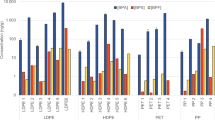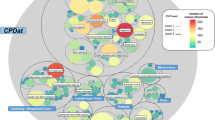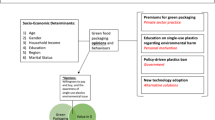Abstract
Packaging materials can be a source of chemical contaminants in food. Process-based migration models (PMM) predict the chemical fraction transferred from packaging materials to food (FC) for application in prioritisation tools for human exposure. These models, however, have a relatively limited applicability domain and their predictive performance is typically low. To overcome these limitations, we developed a linear mixed-effects model (LMM) to statistically relate measured FC to properties of chemicals, food, packaging, and experimental conditions. We found a negative relationship between the molecular weight (MW) and FC, and a positive relationship with the fat content of the food depending on the octanol-water partitioning coefficient of the migrant. We also showed that large chemicals (MW > 400 g/mol) have a higher migration potential in packaging with low crystallinity compared with high crystallinity. The predictive performance of the LMM for chemicals not included in the database in contact with untested food items but known packaging material was higher (Coefficient of Efficiency (CoE) = 0.21) compared with a recently developed PMM (CoE = −5.24). We conclude that our empirical model is useful to predict chemical migration from packaging to food and prioritise chemicals in the absence of measurements.
This is a preview of subscription content, access via your institution
Access options
Subscribe to this journal
Receive 6 print issues and online access
$259.00 per year
only $43.17 per issue
Buy this article
- Purchase on Springer Link
- Instant access to full article PDF
Prices may be subject to local taxes which are calculated during checkout


Similar content being viewed by others
Code availability
All the analyses were carried out in R version 3.5.1 [41] using the following packages: dplyr and reshape2 to rearrange the data [42, 43], ggplot2 and ggeffects to generate the figures presented [44, 45], lme4 to fit the models [46], MuMIn and hydroGOF to compute the goodness of fit measures [47, 48]. The code necessary to generate the models can be accessed upon request to the corresponding author.
References
Muncke J. Food packaging materials. 2012. https://www.foodpackagingforum.org/food-packaging-health/food-packaging-materials.
FDA. Guidance for industry: preparation of premarket submissions for food contact substances: chemistry recommendations. 2007. https://www.fda.gov/Food/GuidanceRegulation/GuidanceDocumentsRegulatoryInformation/ucm081818.htm.
EFSA. Food contact material applications: regulation and guidance. 2017. http://www.efsa.europa.eu/en/applications/foodcontactmaterials/regulationsandguidance.
Healy BF, English KR, Jagals P, Sly PD. Bisphenol A exposure pathways in early childhood: Reviewing the need for improved risk assessment models. J Exposure Sci Environ Epidemiol. 2015;25:544.
Cohen Hubal EA. PFAS: insights from past actions to inform today’s decisions. J Exposure Sci Environ Epidemiol. 2019;29:129–30.
European Commission. Bisphenol A: EU ban on baby bottles to enter into force tomorrow: European Commission; 2011. http://europa.eu/rapid/press-release_IP-11-664_en.htm.
European Food Safety Authority. Contaminants update: first of two opinions on PFAS in food 2018 [03.2019]. https://www.efsa.europa.eu/en/press/news/181213.
Biryol D, Nicolas CI, Wambaugh J, Phillips K, Isaacs K. High-throughput dietary exposure predictions for chemical migrants from food contact substances for use in chemical prioritization. Environ Int. 2017;108:185–94.
Wambaugh JF, Wang A, Dionisio KL, Frame A, Egeghy P, Judson R, et al. High throughput heuristics for prioritizing human exposure to environmental chemicals. Environ Sci Technol. 2014;48:12760–7.
Isaacs KK, Glen WG, Egeghy P, Goldsmith MR, Smith L, Vallero D, et al. SHEDS-HT: an integrated probabilistic exposure model for prioritizing exposures to chemicals with near-field and dietary sources. Environ Sci Technol. 2014;48:12750–9.
Ernstoff A, Niero M, Muncke J, Trier X, Rosenbaum RK, Hauschild M, et al. Challenges of including human exposure to chemicals in food packaging as a new exposure pathway in life cycle impact assessment. Int J Life Cycle Assess. 2019;24:543–52.
Pocas MF, Oliveira JC, Oliveira FA, Hogg T. A critical survey of predictive mathematical models for migration from packaging. Crit Rev Food Sci Nutr. 2008;48:913–28.
Gavriil G, Kanavouras A, Coutelieris FA. Food-packaging migration models: a critical discussion. Crit Rev Food Sci Nutr. 2018;58:2262–72.
Zuur A, Ieno E, Walker N, Saveliev A, Smith G. Mixed effects models and extensions in ecology with R. New York: Springer; 2009.
Garson GD. Hierarchical linear modeling: guide and applications. California, London, New Dehli, Singapore, Washington DC: Sage; 2012.
Sun W, Palazoglu A, Singh A, Zhang H, Wang Q, Zhao Z, et al. Prediction of surface ozone episodes using clusters based generalized linear mixed effects models in Houston–Galveston–Brazoria area, Texas. Atmos Pollut Res. 2015;6:245–53.
Bohora SB, Cao QV. Prediction of tree diameter growth using quantile regression and mixed-effects models. For Ecol Manag. 2014;319:62–6.
Uzoh FCC, Oliver WW. Individual tree diameter increment model for managed even-aged stands of ponderosa pine throughout the western United States using a multilevel linear mixed effects model. For Ecol Manag. 2008;256:438–45.
Ernstoff A, Fantke P, Huang L, Jolliet O. High-throughput migration modelling for estimating exposure to chemicals in food packaging in screning and prioritization tools. Food Chem Toxicol. 2017;109:428–38.
US. Food and Drug administration. Guidance for industry: preparation of premarket submissions for food contact substances (Chemistry recommendations). 2007. https://www.fda.gov/Food/GuidanceRegulation/GuidanceDocumentsRegulatoryInformation/ucm081818.htm.
Commission Regulation (EU) No 10/2011 of 14 January 2011 on plastic materials and articles intended to come into contact with food, 2011R0010. 2011.
Fang X, Vitrac O. Predicting diffusion coefficients of chemicals in and through packaging materials. Crit Rev Food Sci Nutr. 2017;57:275–312.
Tehrany EA, Desobry S. Partition coefficients in food/packaging systems: a review. Food Addit Contam. 2004;21:1186–202.
Canellas E, Aznar M, Nerín C, Mercea P. Partition and diffusion of volatile compounds from acrylic adhesives used for food packaging multilayers manufacturing. J Mater Chem. 2010;20:5100–9.
Widen H, Leufven A, Nielsen T. Migration of model contaminants from PET bottles: influence of temperature, food simulant and functional barrier. Food Addit Contam. 2004;21:993–1006.
Chea V, Angellier-Coussy H, Peyron S, Kemmer D, Gontard N. Poly(3-hydroxybutyrate-co-3-hydroxyvalerate) films for food packaging: physical–chemical and structural stability under food contact conditions. J Appl Polym Sci. 2016;133:41850–8.
Goulas A. Overall migration from commercial coextruded food packaging multilayer films and plastics containers into official EU food simulants. Eur Food Res Technol. 2001;212:597–602.
Sanches-Silva A, Andre C, Castanheira I, Cruz JM, Pastorelli S, Simoneau C, et al. Study of the migration of photoinitiators used in printed food-packaging materials into food simulants. J Agric Food Chem. 2009;57:9516–23.
Commission regulation (EU) No 10/2011, 10/2011. 2011.
Lau O-W, Wong S-K. Contamination in food from packaging material. J Chromatogr A. 2000;882:255–70.
Limam M, Tighzert L, Fricoteaux F, Bureau G. Sorption of organic solvents by packaging materials: polyethylene terephthalate and TOPAS®. Polym Test. 2005;24:395–402.
Mercea P. Physicochemical processes involved in migration of bisphenol A from polycarbonate. J Appl Polym Sci. 2009;112:579–93.
Bhunia K, Sablani SS, Tang J, Rasco B. Migration of chemical compounds from packaging polymers during microwave, conventional heat treatment, and storage. Compr Rev Food Sci Food Saf. 2013;12:523–45.
Alin J, Hakkarainen M. Type of polypropylene material significantly influences the migration of antioxidants from polymer packaging to food simulants during microwave heating. J Appl Polym Sci. 2010;118:1084–93.
Fang H, Wang J, Lynch RA. Migration of di(2-ethylhexyl)phthalate (DEHP) and di- n -butylphthalate (DBP) from polypropylene food containers. Food Control. 2017;73:1298–302.
Schielzeth H, Nakagawa S, Freckleton R. Nested by design: model fitting and interpretation in a mixed model era. Methods Ecol Evol. 2013;4:14–24.
Nakagawa S, Schielzeth H, O’Hara RB. A general and simple method for obtaining R2 from generalized linear mixed-effects models. Methods Ecol Evol. 2013;4:133–42.
Assink M, Wibbelink CJM. Fitting three-level meta-analytic models in R: a step-by-step tutorial. Quant Methods Psychol. 2016;12:154–74.
Breiman L, Cutler A. Random forests. 2002. https://www.stat.berkeley.edu/~breiman/RandomForests/cc_home.htm#varimp.
Roberts DR, Bahn V, Ciuti S, Boyce MS, Elith J, Guillera-Arroita G, et al. Cross-validation strategies for data with temporal, spatial, hierarchical, or phylogenetic structure. Ecography. 2017;40:913–29.
R Core Team. R: a language and environment for statistical computing. Vienna, Austria: R Foundation for Statistical Computing; 2016.
Wickham H, Francois R, Henry L, Müller K. dplyr: A grammar of data manipulation. R package version 0.8.0.1. (2019). https://CRAN.R-project.org/package=dplyr.
Hadley W. Reshaping data with the reshape package. J Stat Softw. 2007;21:1–20. http://www.jstatsoft.org/v21/i12/.
Wickham H. ggplot2: elegant graphics for data analysis. J Stat Softw. 2010;35:65–88.
Lüdecke D. ggeffects: tidy data frames of marginal effects from regression models. J Open Source Softw. 2018;3:772.
Bates D, Maechler M, Bolker B, Walker S. Fitting linear mixed-effects models using lme4. J Stat Softw. 2015;67:1–48.
Barton K. MuMIn: Multi-model inference. R package version 1.42.1. (2018). https://CRAN.R-project.org/package=MuMIn.
Bigiarini MZ, Bigiarini MMZ Package “hydroGOF”. R-package. 2013. wwwr-project.org/. Accessed 7 May 2018.
Ozaki A, Gruner A, Störmer A, Brandsch R, Franz R. Correlation between partition coefficients polymer/food simulant, KP, F, and octanol/water, log POW-a new approach in support of migration modeling and compliance testing. Dtsch Lebensm-Rundsch. 2010;106:203–8.
Seiler A, Bach A, Driffield M, Paseiro Losada P, Mercea P, Tosa V, et al. Correlation of foodstuffs with ethanol-water mixtures with regard to the solubility of migrants from food contact materials. Food Addit Contam Part A Chem Anal Control Expo Risk Assess. 2014;31:498–511.
Marcato B, Guerra S, Vianello M, Scalia S. Migration of antioxidant additives from various polyolefinic plastics into oleaginous vehicles. Int J Pharm. 2003;257:217–25.
Cai H, Ji S, Zhang J, Tao G, Peng C, Hou R, et al. Migration kinetics of four photo-initiators from paper food packaging to solid food simulants. Food Addit Contam Part A Chem Anal Control Expo Risk Assess. 2017;34:1632–42.
Kawamura Y, Ogawa Y, Mutsuga M. Migration of nonylphenol and plasticizers from polyvinyl chloride stretch film into food simulants, rapeseed oil, and foods. Food Sci Nutr. 2017;5:390–8.
Diduch M, Polkowska Z, Namiesnik J. Factors affecting the quality of bottled water. J Exposure Sci Environ Epidemiol. 2013;23:111–9.
Pocas MF, Oliveira JC, Brandsch R, Hogg T. Feasibility study on the use of probabilistic migration modeling in support of exposure assessment from food contact materials. Risk Anal. 2010;30:1052–61.
Todeschini R, Consonni V. Molecular descriptors for chemoinformatics, Volumes I and II. Mannhold R, Kubinyi H, Folkers G, editors. Weinheim, German: Wiley-VCH; 2009.
Gramatica P, Chirico N, Papa E, Cassani S, Kovarich S. QSARINS: a new software for the development, analysis, and validation of QSAR MLR models. J Computational Chem. 2013;34:2121–32.
Mamy L, Patureau D, Barriuso E, Bedos C, Bessac F, Louchart X, et al. Prediction of the fate of organic compounds in the environment from their molecular properties: a review. Crit Rev Environ Sci Technol. 2015;45:1277–377.
Pirovano A, Brandmaier S, Huijbregts MA, Ragas AM, Veltman K, Hendriks AJ. The utilisation of structural descriptors to predict metabolic constants of xenobiotics in mammals. Environ Toxicol Pharmacol. 2015;39:247–58.
Pirovano A, Huijbregts M, Ragas A, Veltman K, Hendriks AJ. Mechanistically-based QSARs to describe metabolic constants in mammals. ATLA 2014;42:59–69.
Papa E, van der Wal L, Arnot JA, Gramatica P. Metabolic biotransformation half-lives in fish: QSAR modeling and consensus analysis. Sci Ttal Environ. 2014;470–471:1040–6.
Gramatica P, Cassani S, Sangion A. Aquatic ecotoxicity of personal care products: QSAR models and ranking for prioritization and safer alternatives’ design. Green Chem. 2016;18:4393–406.
Vitrac O, Lézervant J, Feigenbaum A. Decision trees as applied to the robust estimation of diffusion coefficients in polyolefins. J Appl Polym Sci. 2006;101:2167–86.
Hartle JC, Fox MA, Lawrence RS. Probabilistic modeling of school meals for potential bisphenol A (BPA) exposure. J Exposure Sci Environ Epidemiol. 2016;26:315–23.
Acknowledgements
We would like to thank Tanja Radusin (Nofima, Institute for food technology), Jorunn Nilsen, and Siw Bodil Fredriksen (Norner) for their help in better understanding the properties driving migration from plastic packaging. We also thank two anonymous reviewers for their comments to improve the paper’s structure and readability. This project was funded by the European Union’s Horizon 2020 research and innovation programme under the Marie Sklodowska-Curie grant agreement No 641459 (RELIEF).
Author information
Authors and Affiliations
Corresponding author
Ethics declarations
Conflict of interest
The authors declare that they have no conflict of interest.
Additional information
Publisher’s note Springer Nature remains neutral with regard to jurisdictional claims in published maps and institutional affiliations.
Supplementary information
Rights and permissions
About this article
Cite this article
Douziech, M., Benítez-López, A., Ernstoff, A. et al. A regression-based model to predict chemical migration from packaging to food. J Expo Sci Environ Epidemiol 30, 469–477 (2020). https://doi.org/10.1038/s41370-019-0185-7
Received:
Revised:
Accepted:
Published:
Issue Date:
DOI: https://doi.org/10.1038/s41370-019-0185-7



